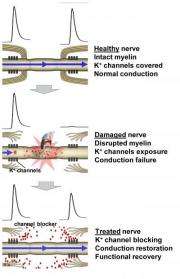Drug studied as possible treatment for spinal injuries

Researchers have shown how an experimental drug might restore the function of nerves damaged in spinal cord injuries by preventing short circuits caused when tiny "potassium channels" in the fibers are exposed.
The chemical compound also might be developed as a treatment for multiple sclerosis.
Because nerves usually are not severed in a common type of spinal cord trauma, called "compression" injuries, the drug offers hope as a possible treatment, said Riyi Shi, a professor in Purdue University's Department of Basic Medical Sciences, School of Veterinary Medicine, Center for Paralysis Research and Weldon School of Biomedical Engineering.
"Compression is responsible for most spinal cord injuries, including many resulting in paralysis," Shi said. "Since the nerves are not severed, this type of drug represents a potential golden opportunity to treat spinal cord injuries."
The experimental compound, 4-aminopyridine-3-methyl hydroxide, has been shown to restore function to damaged axons, slender fibers that extend from nerve cells and transmit electrical impulses in the spinal cord.
Findings, based on experiments with guinea pig spinal cord tissue, appeared online Wednesday (Nov. 18) in the Journal of Neurophysiology. The work was led by Department of Basic Medical Sciences doctoral student Wenjing Sun.
Shi said the findings were made possible by the interdisciplinary nature of the work, which also involves researchers Richard Borgens, director of Purdue's Center for Paralysis Research and the Mari Hulman George Professor of Neurology in the School of Veterinary Medicine; Stephen Byrn, the Charles B. Jordan Professor of Medicinal Chemistry, and Daniel Smith, a research assistant professor, both in the Department of Industrial and Physical Pharmacy; and Ji-Xin Cheng, an associate professor in the Weldon School of Biomedical Engineering and Department of Chemistry.
The researchers subjected spinal cord tissue to stresses that mimic what happens in a compression injury, which stretches nerves. Then they treated the damaged axons with 4-aminopyridine-3-methyl hydroxide.
The compound is a derivative of the drug 4-aminopyridine, used primarily as a research tool and also to manage symptoms of multiple sclerosis.
The axons of each nerve are sheathed in a thick insulating lipid layer, called myelin, which enables the transmission of signals without short circuiting, much like the insulation surrounding electrical wires. Spinal cord trauma damages the myelin sheath, exposing "fast potassium channels" that are embedded in the axons and are critical for transmitting nerve impulses.
The researchers confirmed previous circumstantial evidence suggesting injury causes the myelin insulation to recede, exposing the channels and impairing signal transmission. Laboratory and imaging techniques revealed the exposed channels in damaged axons.
The researchers also discovered that 4-aminopyridine-3-methyl hydroxide is a "potassium channel blocker," using a sophistic laboratory technique called "patch clamp" to measure signal conduction. Findings confirmed that the compound prevents the exposed channels from leaking electrical current and enhances nerve conduction in segments of the damaged spinal cord.
The compound could make it possible to sidestep spinal cord damage by enabling axons to transmit signals as though they were still sheathed in myelin, Shi said.
Nerves transmit signals through a series of rapid electrical pulses, or "action potentials." For proper nerve function, the time gap between pulses must be as brief as possible. However, 4-aminopyridine has been shown to lengthen the gap, or "refractory period," between pulses. The researchers found that 4-aminopyridine-3-methyl hydroxide restores function without affecting the refractory period. As a result, the damaged nerves perform more like healthy nerves than those treated with other drugs, he said.
Another key advantage of the new compound is that it's about 10 times more potent than 4-aminopyridine, meaning lower doses can be used to reduce the likelihood of serious side effects.
Because myelin also is damaged in multiple sclerosis, the same drug might be used to restore nerve function in people stricken with the disease, Shi said. Since the newer drug can be used in lower doses, it might be more effective than 4-aminopyridine in treating multiple sclerosis, which affects more than 350,000 people in the United States and 2 million worldwide, he said.
Source: Purdue University (news : web)













